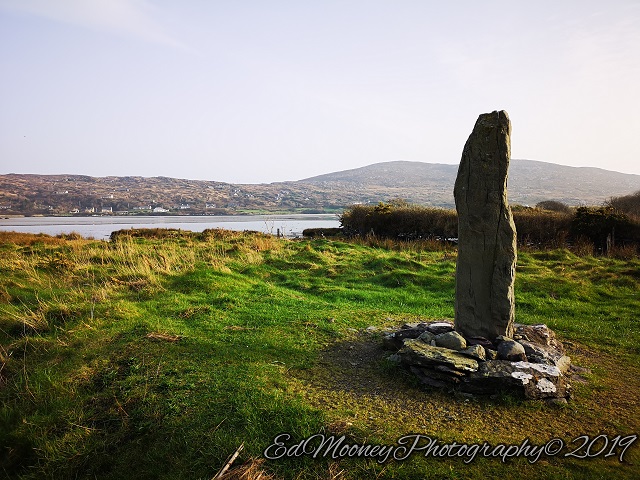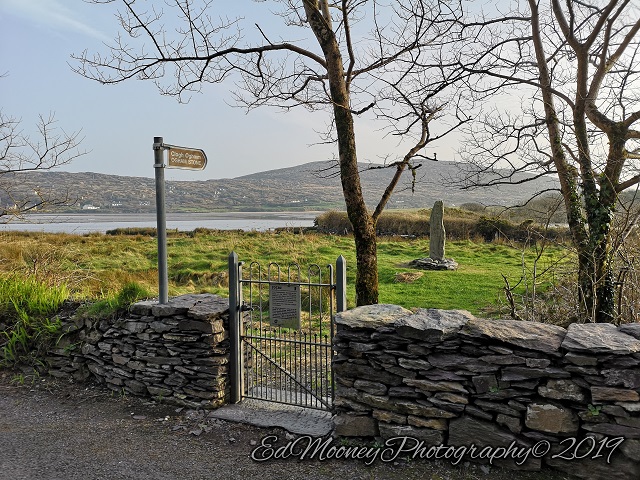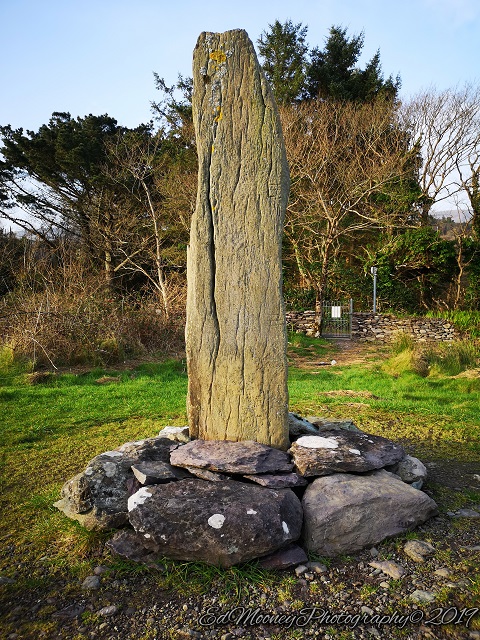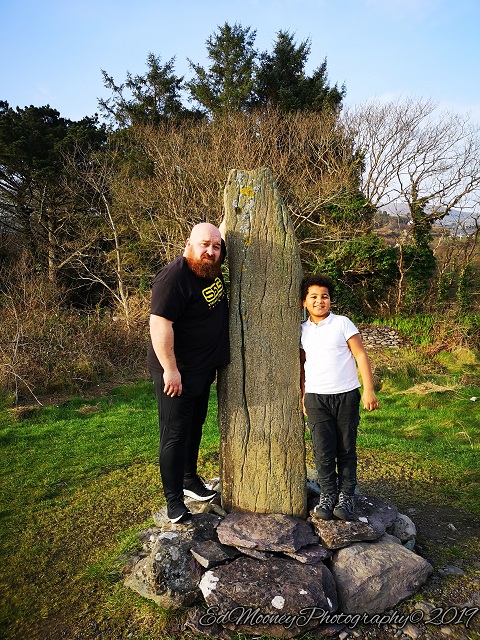
On a recent trip to Kerry I got the opportunity to do a little sightseeing and temporarily resurrect ‘The Ruinhunter’ 😊. I’ve missed exploring over the last few years and although I have no immediate plans to resume on a regular basis, the passion is still there and I wanted to share my experience with you. I will eventually return too my endeavors but current circumstances don’t afford too many opportunities. So, until this changes I will endeavor to post when and where the opportunity arises. First up was a rare favourite find of mine, An Ogham Stone, at Derrynane in Co. Kerry, also known as the Caherdaniel Ogham Stone, or by its Gaelic name Cloch Oghaim Dhoire Fhíonáin Beag, it is said to date back to 500 – 550A.D. This is only the 3rd, well fourth Ogham stone I have encountered if you count the two found in Ardmore. The first I found way back in 2014 at Donard.

Ogham is basically a 25-letter alphabet which is said to be based on the Roman alphabet. It is believed to be the earliest known form of writing in Ireland, which dates to approx. 4th century A.D. and was in use for around 500 years. This alphabet is made up of twenty-five characters which are represented by a series of straight or slanted lines. In early Christian times the Ogham Stone appear to have been used as commemorative stones, normally to mark someone’s final resting place or as boundary marker. Interestingly Ogham is sometimes referred to as the “Celtic Tree Alphabet” as many of the characters relate to the sacred trees of Ireland. Want to know more? Check out a fantastic piece ogham-the secret code of our ancestors by fellow blogger Ali Isaac.
According to the National Monuments Service the stone was uncovered under water on the Derrynane strand before being moved to its current location by the Office of Public Works back in the 1940’s. It’s quite easy to find the stone and is clearly signposted from the road. The stone itself as you could imagine is extremely eroded, no doubt from spending who knows how long submerged under water. The stone stands at over 2 meters in height and is made from Sandstone. Sadly, erosion makes it almost impossible to decipher the inscription, however having read the stone, R.A.S. Macalister in his (Corpus Inscriptionum Insularum Celticarum, 1945) gives us the following ‘ANM LLATIGNI MAQ M[I]N[E]RC M[UCOI] Q[…]CI’. As you can see much of the inscription was missing even back then. The only translation I managed to find was from Wikipedia as follows, (“name of Llatigni, son of Minerc, of the tribe of Q…ci”).

Despite the fact that this sheds no light on the historical significance of the stone, it still remains for me a fascinating piece of our heritage and history. Which is now thankfully subject to a preservation order.

For these and more of my images, why not visit my Website





Great to see the Ruinhunter is back in business, even if only sporadically. 😊 I’ve missed your posts and images. That’s a mighty stone you found, there…
LikeLiked by 1 person
Thanks Ali, forgot how much I enjoyed doing it and catching up with everyone. Kerry is an amazing place, hope to spend alot more time down there.
LikeLike
Yes, its very historic, and beautiful. Well, wherever you are, keep up the good blogging! 😉
LikeLiked by 1 person
Thanks for sharing! What a mystery, your stone. It’s dating back to 500 AD makes it quite spectacular.
LikeLiked by 1 person
What a beautiful shot of the ogham stone, Ed! Thank you for sharing it, and the history behind the stone.
LikeLiked by 1 person
Hi Melissa, nice to hear from you, glad you enjoyed it, hope to have more soon,
Ed
LikeLike
Forgot how much I missed not only your cool photos, but your informative blog as well. I hope you’re able to post more. Even a little more frequently would be a great treat.
LikeLiked by 1 person
Cheers bro, Im a bit rusty, cant believe it was three years to the day. Hope to eventually return to more frequent posts 🙂
LikeLiked by 1 person
Fantastic post, Ed. Thanks for the translations from the Ogham stone, too. They are truly amazing. I thought I saw one in a field just outside Ardmore.
LikeLiked by 1 person
Thanks Jean, Its been a while, the only ones I found in Ardmore where in the Abbey, but I believe there is a standing stone nearby, perhaps thats what you saw?
LikeLiked by 1 person
That must have been it.
LikeLiked by 1 person
Great post Ed great to see you back 💜
LikeLiked by 1 person
Thank you so much 🙂
LikeLike
💜💜
LikeLiked by 1 person
Lovely to see your post pop up in my inbox, Ed!
LikeLiked by 1 person
Thanks a mill Sue, great to be back, and catch up with everyone
LikeLike
We went to see an ogham stone in Cornwall at Leswannick. It’s in the church although I can’t trace a single web page about it.
LikeLike
Hi John, Is that the one in St. Martins Church
http://babelstone.blogspot.com/2009/11/ogham-stones-of-cornwall-and-devon.html
LikeLike
Fáilte ar ais, a chara! I’ve been to Ardmore but I didn’t know about the ogham stones! Next time …
LikeLiked by 1 person
Hey, There inside the Abbey, good to hear from you 🙂
LikeLiked by 1 person
I am so happy you are back. A little is better than not at all !
LikeLike
Thank You Veronica 🙂
LikeLiked by 1 person
Ed I have missed your posts! I have been similarly overwhelmed and not able to blog much. I look forward to anything you have the time to post.
LikeLiked by 1 person
Ah Thank You, I didnt realize how much I missed doing this until yesterday. Great to be back and catching up with everyone 🙂
LikeLike
Very fascinating. We were right there in September and I missed it! Thanks for the info, I will not miss it on the next trip!
LikeLiked by 1 person
Glad you liked it, there are some beautiful spots nearby
LikeLike
Welcome back Ed. Look forward to more gems from you. Have now achieved 90 years and eyesight below par but still photographing – unfortunately not in Ireland! Hope you are keeping well. Des
LikeLiked by 1 person
Hi Des, great too be back. All is well, glad too see your still going strong. There’s Hope for me yet👍
LikeLike
Good to have you back, Ed!
LikeLiked by 1 person
Cheers bro
LikeLike
Great to see the ruin hunter return for a brief one! Love that stone, so cool.
Cheers
MTM
LikeLiked by 1 person
Cheers Pal, hope to make a more regular appearance
Ed
LikeLike
Excellent. 😁
LikeLiked by 1 person
You have been missed Ed, nice to see you even for a brief one. Ogman Stones fascinate me, the very age of them, and many are found in the fabricate of old churches. Thanks for this one 🙂 Lynne
LikeLiked by 1 person
Thank you Lynne, They are fascinating,
LikeLiked by 1 person
Pingback: Ruinhunter 2.0 | Ed Mooney Photography
Reblogged this on Red Fox Dancing and commented:
Ever wanted to know what a Ruinhunter does?
Check out Ed Mooney
LikeLiked by 1 person
Wow, hanks a mill Gary, what a great story, thanks for the share, I look forward to following,
Ed
LikeLike